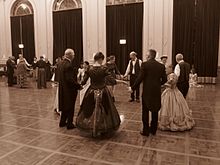Ball (dance party)

Aristocrats gathering around Emperor Franz Joseph at a ball in the Hofburg Imperial Palace, painting by Wilhelm Gause (1900)

A ball at the Russian imperial court in the 1910s

Budapest Székely Ball

Five partner dance at a Colonial Ball in the Albert Hall Canberra (circa 2016) (sepia)
A ball is a formal dance party.
Social dance forms a large part of the evening; actual ballroom dancing may or may not occur.
Contents
1 Etymology
2 Types
3 Example of a country ball in Georgian England
4 See also
5 References
6 Further reading
7 External links
Etymology
The word "ball" derives from the Latin word ballare, meaning "to dance"; the Latin word also developed into French baller—from where it swapped into languages like English or German—, and bailar, the Spanish and Portuguese verbs for "to dance" (although all three Romance languages also know danser, danzar and dançar respectively). Catalan uses the same word, ball, for the dance event.
Types
- Cotillion ball
- Commemoration ball
- Hunt ball
- Masquerade ball
- May Ball
- Dance party
- Prom
Example of a country ball in Georgian England
A well-documented ball occurred at Kingston Lacy, Dorset, England, on 19 December 1791. The occasion was to celebrate the completion of major alterations to the house and the event was organised by Frances Bankes, wife of Henry Bankes, owner of the house. The event involved 140 guests, with dancing from 9pm to 7am, interrupted by dinner at 1am.[1]
See also

An American dance card from 1884
- Ball gown
- Ballroom
- Dance card
References
^ "Frances Bankes' ball at Kingston Lacy 19 December 1791 (From Regency History)". Regency History.net. Retrieved 2014-01-03..mw-parser-output cite.citationfont-style:inherit.mw-parser-output .citation qquotes:"""""""'""'".mw-parser-output .citation .cs1-lock-free abackground:url("//upload.wikimedia.org/wikipedia/commons/thumb/6/65/Lock-green.svg/9px-Lock-green.svg.png")no-repeat;background-position:right .1em center.mw-parser-output .citation .cs1-lock-limited a,.mw-parser-output .citation .cs1-lock-registration abackground:url("//upload.wikimedia.org/wikipedia/commons/thumb/d/d6/Lock-gray-alt-2.svg/9px-Lock-gray-alt-2.svg.png")no-repeat;background-position:right .1em center.mw-parser-output .citation .cs1-lock-subscription abackground:url("//upload.wikimedia.org/wikipedia/commons/thumb/a/aa/Lock-red-alt-2.svg/9px-Lock-red-alt-2.svg.png")no-repeat;background-position:right .1em center.mw-parser-output .cs1-subscription,.mw-parser-output .cs1-registrationcolor:#555.mw-parser-output .cs1-subscription span,.mw-parser-output .cs1-registration spanborder-bottom:1px dotted;cursor:help.mw-parser-output .cs1-ws-icon abackground:url("//upload.wikimedia.org/wikipedia/commons/thumb/4/4c/Wikisource-logo.svg/12px-Wikisource-logo.svg.png")no-repeat;background-position:right .1em center.mw-parser-output code.cs1-codecolor:inherit;background:inherit;border:inherit;padding:inherit.mw-parser-output .cs1-hidden-errordisplay:none;font-size:100%.mw-parser-output .cs1-visible-errorfont-size:100%.mw-parser-output .cs1-maintdisplay:none;color:#33aa33;margin-left:0.3em.mw-parser-output .cs1-subscription,.mw-parser-output .cs1-registration,.mw-parser-output .cs1-formatfont-size:95%.mw-parser-output .cs1-kern-left,.mw-parser-output .cs1-kern-wl-leftpadding-left:0.2em.mw-parser-output .cs1-kern-right,.mw-parser-output .cs1-kern-wl-rightpadding-right:0.2em
Further reading
Wallace, Carol McD.; et al. (1986). Dance: a very social history. New York: The Metropolitan Museum of Art. ISBN 9780870994869.
External links
 Media related to Balls (dance) at Wikimedia Commons
Media related to Balls (dance) at Wikimedia Commons

